Posted November 3, 2019
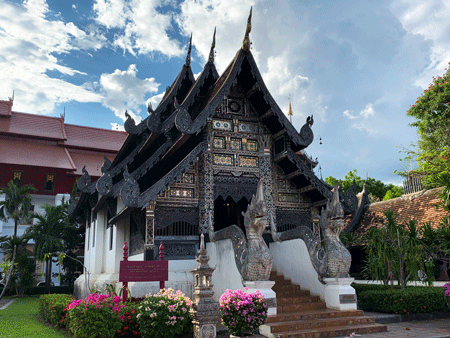
“Chat With Monk“
Steve spotted the sign, “Chat With Monk”. And yes, that’s exactly what I wanted to do.
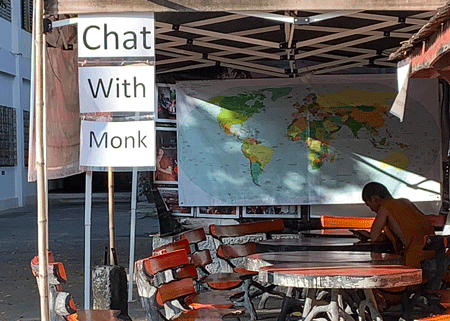
We’ve seen monks all over Thailand and Myanmar in their distinctive orange robes, walking in town, on the bus, in restaurants, and in Wats (Buddhist temples).
Monks are a mystery to me. They seem very private and keep to themselves. Now was my possibly one and only chance to actually talk to a monk and get the inside scoop, direct from the guy in orange (meant with the utmost respect).
Wat Chedi Luang
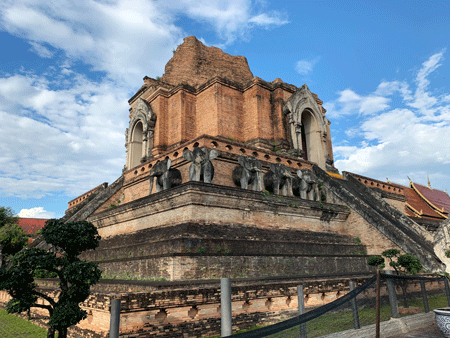
We were visiting Wat Chedi Luang, in Chiang Mai, Thailand, when we seized the opportunity to chat with a monk.
There were six round teak tables under a free standing shade canopy in the chat area. One monk sat at a table in front of a huge wall map of the world. He was the one and only monk there. He sat in his orange robe, draped over one shoulder, with the other shoulder bare. We walked over and sat at his table, in the shade of the canopy.
Monk in Training
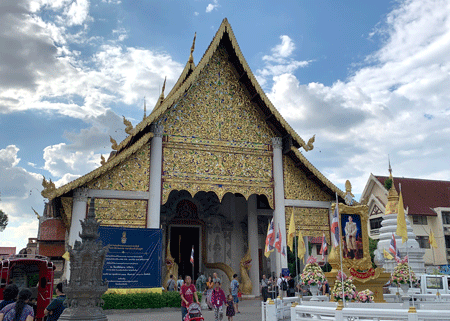
The first thing I noticed was his youthful look and huge smile. I asked him if it was o.k. to ask his age, and he said, “that is a question that is common”, so I assumed that was a yes. He told me he was 18, and he was a Monk in training.
So Young
Chai decided to become a monk when he was only eight years old. He was born and raised in Myanmar, in the upper northeastern region. Chai was surprised to learn that we had just come from Myanmar yesterday. We had spent 4 nights in Yangon. He said he was from the far northeast of Myanmar, far from Yangon.

So, at the young age of eight, Chai left his family to live with the monks. He has been a monk in training for the past ten years. Ten years!
I wonder if he even remembers a life before becoming a monk.

Chai has lived at Wat Chedi Luang, where we were chatting with him, for the past five months. Monks move, live and study at different wats, with different teachers, as part of their training.
It’s incredible that Chai came to Thailand from Myanmar just under two years ago knowing only his Burmese dialect. He had to learn Thai, and is now learning English (and he’s quite good). In fact he was reading a copy of The Secret Garden when we stopped to chat with him. It was a learner copy, with some Thai text on the bottom of each page, to help him along.
Tough Circumstances
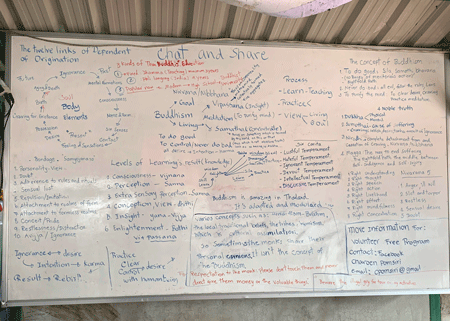
Chai said many monks go to the university, but he cannot attend the university because he is not Thai. He said his current teacher, a Monk, has a degree in Philosophy and Psychology from the Chiang Mai University. His current teacher filled the entire white board in the chatting area full of Buddhist wisdom, titled “Chat and Share”.
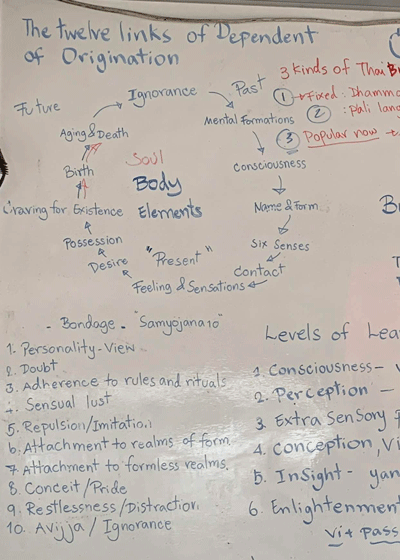
I asked if he would want to go to university in Myanmar, since he obviously valued education and couldn’t attend in Thailand. He told me he couldn’t do that either, because he is not a Burmese citizen. That surprised me because he had told me he was born in Myanmar. He explained that he is Shan. Shan are an ethnic minority in Myanmar and he is not considered a Burmese citizen, even though he was born in Myanmar.
Wow, what a wake up call to be chatting with someone in such circumstances. Although he was only eight at the time, perhaps that factored into his decision to become a monk, with his limited options in Myanmar. I’m not sure someone so young can understand their place in a restrictive regime, but just maybe he or his family did.
A Happy Monk

Chai seemed very happy with his decision to be a monk. He explained that monks always have the choice to stay or leave. He said that now that he is age 18, he has made the decision again, as an adult, to stay. I wondered if monks are typically committed for life, once they start on the monk path. He said some men are only monks for five minutes, one month, one year, or some are forever. And it sounded like there is no stigma if someone should choose to leave the monkhood.
Young Monks

I asked about the number of monks at the Wat. Chai said there are 50 “full” monks, and 200 young monks in training. Once he is age 20, he will be a “full” monk. So that means that 200 of the monks at the wat are under age 20. Wow, sounds like monk recruiting is going quite well.
Sunrise Donations
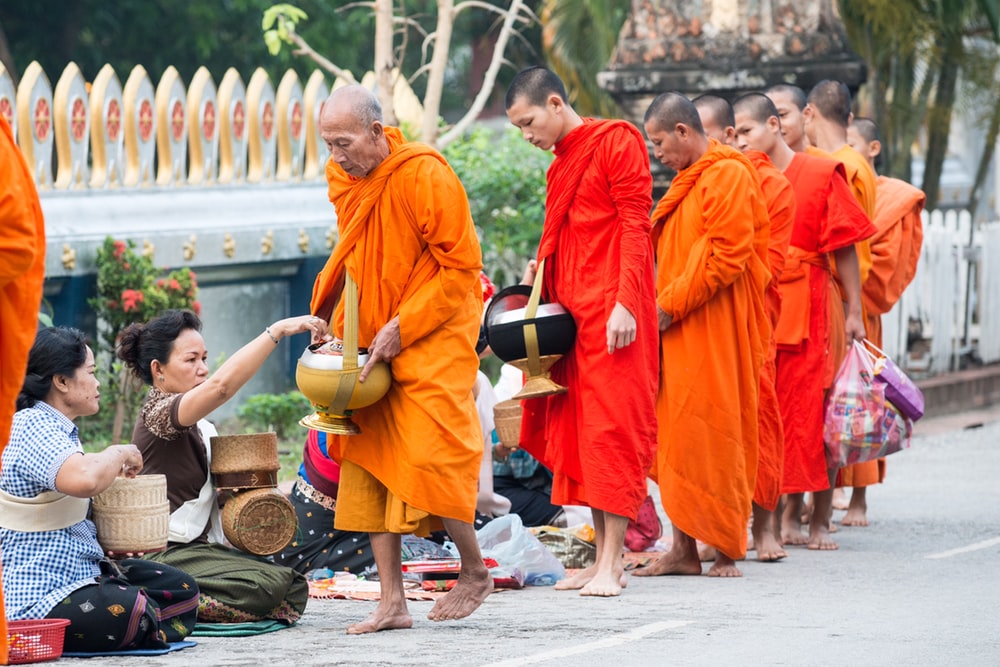
Chai explained that the monks live on only donations and have no possessions (other than books to study and bare necessities). They get up before dawn and walk the streets of their community, each carrying a bowl for donations.
Buddhist devotees believe that offering alms secures them good karma in this life and the next. They also hope to bestow good luck on deceased family members by donating to the monks. As the monks pass by in the early morning hours, people put fruit, food, and money into their bowls. Whatever Chai gets in his bowl, he can keep for his needs.
The Cafeteria
I asked if the Monks have a cafeteria at the wat compound. I did think about whether I should use the word cafeteria, since it’s kind of a big word, and I’d been careful to use simple words as much as possible in our conversation. Chai looked confused and wasn’t sure what the word cafeteria meant. I explained that a cafeteria is a large room where the Monks eat together. And now Chai has a new word. You’re welcome.
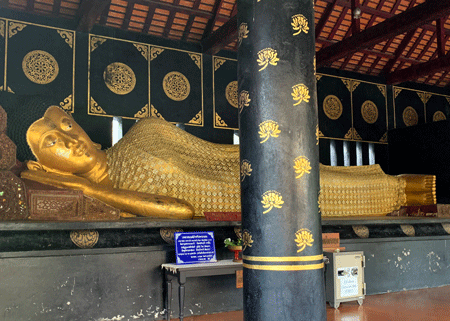
Chai told us that people from the community volunteer to cook lunch for the Monks every day at the wat. Turns out Monks do not eat after midday, so their meager breakfast and community lunch are it for the day. No wonder most monks are so slender.
Fast Friends
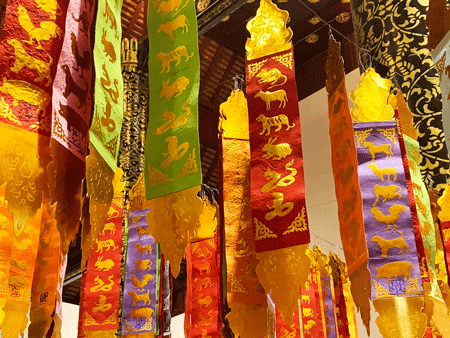
I had read that women need to be very careful to not touch or accidentally brush up against a monk. It’s best to not even sit next to a monk on a bus or train, if possible. I had also read (I thought) that it’s not good form to take a monk’s picture.
By now Chai, Steve, and I had chatted for close to 45 minutes. I’d shown Chai pictures of where we live in Seattle, we showed him our city on the world map, we talked about snow and why it’s expensive to live in California and New York, and I showed him pictures of my kids and pets.
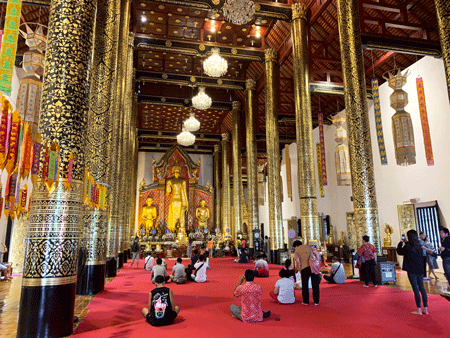
I felt like we were fast friends. Chai was so personable, open, and quick to smile. I really, really wanted a picture of Chai, so I went ahead and asked, “Is it ok to get a picture of you?”. He smiled widely and said a big, “Yes, of course, it is fine”, which surprised me, but made me very happy. I guess all my efforts to avoid taking a monks picture were unnecessary. Who knew?
The New Monk
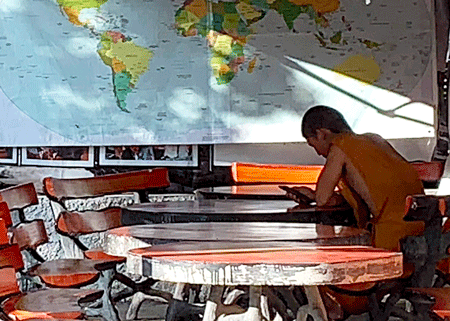
By then another young monk, who I’ll call the new monk, who didn’t seem at all interested in chatting, had joined the table. The new monk sat consumed by some videos on his cell phone (I’m guessing even teen monks need screen-time limits – haha). Chai suggested that new monk snap a picture of us.
The Picture
To orchestrate the picture taking, Chai told Steve to join him on his bench. He made it very clear that I should stay on my own, separate bench, that had a gap of a few inches from his bench. It was important that I stay a safe distance from him. I wonder if he can hug his own mom. Probably not, and I didn’t think to ask until after we had left (but I did find out that he sees his family regularly – and had just seen his mom last week).
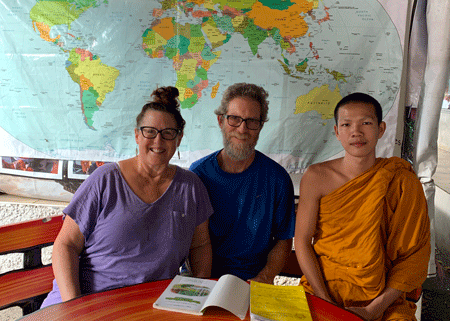
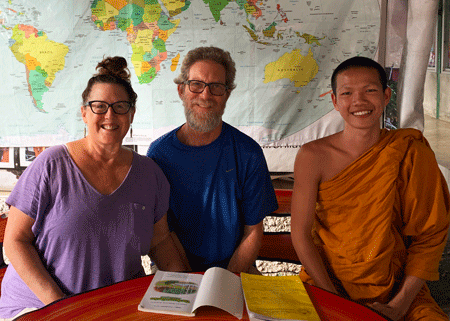
The new monk took our picture and handed me back my cellphone. I took a quick peek at the picture, and saw that Chai hadn’t smiled. He looked so serious and not like himself at all. I felt we had enough of a rapport that I chimed right up and said I really wanted a picture with Chai smiling, since he has such a nice smile. He smiled at that (of course), and agreed to retake the photo.
Good Karma
I’m so very happy that I had the good fortune (karma?) to meet Chai today. I have a new perspective and understanding of monks, their life and deep commitment, kindness, and their pursuit of nirvana.
It is an experience I will never forget.